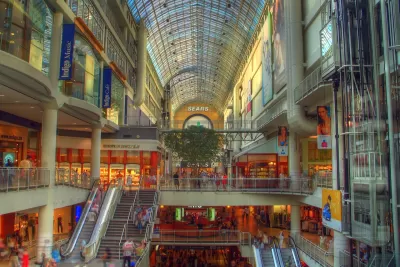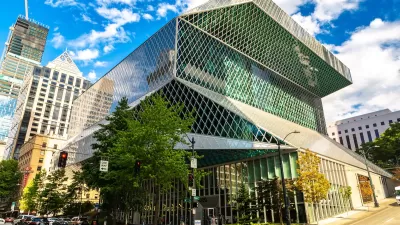The origin story of one of the definitively American typologies—the shopping mall—is one of unintended consequences run amok. Could the next chapter of this story come closer to the author's intention?

Anne Quito sets the stage for a critical re-evaluation of the value and role of the shopping mall in the history of the American landscape:
"As sociologists and urban planners debate the relevance of these classic American brick-and-mortar shopping spaces in the era of e-commerce and Amazon Prime Day, a group of architecture enthusiasts will gather this weekend to celebrate the birthday of Victor Gruen, the man known as 'father of the modern shopping mall,' and the first annual Gruen Day."
The organizers of the event credit Gruen with a novel and popular form of third space—outside of the home and office. In recent years, however, shopping malls are threatened from an economic standpoint by online shopping and recession, while the narrative about car culture, with the shopping mall as one of its iconic symbols, has shifted in tone.
Quito notes, however, that Gruen hated cars, and designed his first malls to encourage walking—a great idea that "backfired." Gruen is on record saying that the "bastard" versions of his vision "destroyed our cities."
Quito concludes by examining the possibility that the rebirth of shopping malls, following their recent and current struggles, might bring their reality closer in line with Gruen's original vision.
FULL STORY: The father of the American shopping mall hated what he created

Planetizen Federal Action Tracker
A weekly monitor of how Trump’s orders and actions are impacting planners and planning in America.

Congressman Proposes Bill to Rename DC Metro “Trump Train”
The Make Autorail Great Again Act would withhold federal funding to the system until the Washington Metropolitan Area Transit Authority (WMATA), rebrands as the Washington Metropolitan Authority for Greater Access (WMAGA).

DARTSpace Platform Streamlines Dallas TOD Application Process
The Dallas transit agency hopes a shorter permitting timeline will boost transit-oriented development around rail stations.

LA County Creating Action Plan to Tackle Extreme Heat
Los Angeles County is creating a Heat Action Plan to help communities stay safe during extreme heat, with steps like adding more shade, improving buildings, and supporting the neighborhoods most at risk.

Maryland Plans Quick-Build Complete Streets Projects
The state will use low-cost interventions to improve road safety in five Maryland counties.

Downtown Los Angeles Gears Up for Growth
A new report highlights Downtown L.A.’s ongoing revival through major housing projects, adaptive reuse, hospitality growth, and preparations for global events in the years ahead.
Urban Design for Planners 1: Software Tools
This six-course series explores essential urban design concepts using open source software and equips planners with the tools they need to participate fully in the urban design process.
Planning for Universal Design
Learn the tools for implementing Universal Design in planning regulations.
City of Charlotte
Municipality of Princeton
Roanoke Valley-Alleghany Regional Commission
City of Camden Redevelopment Agency
City of Astoria
Transportation Research & Education Center (TREC) at Portland State University
US High Speed Rail Association
City of Camden Redevelopment Agency
Municipality of Princeton (NJ)



























